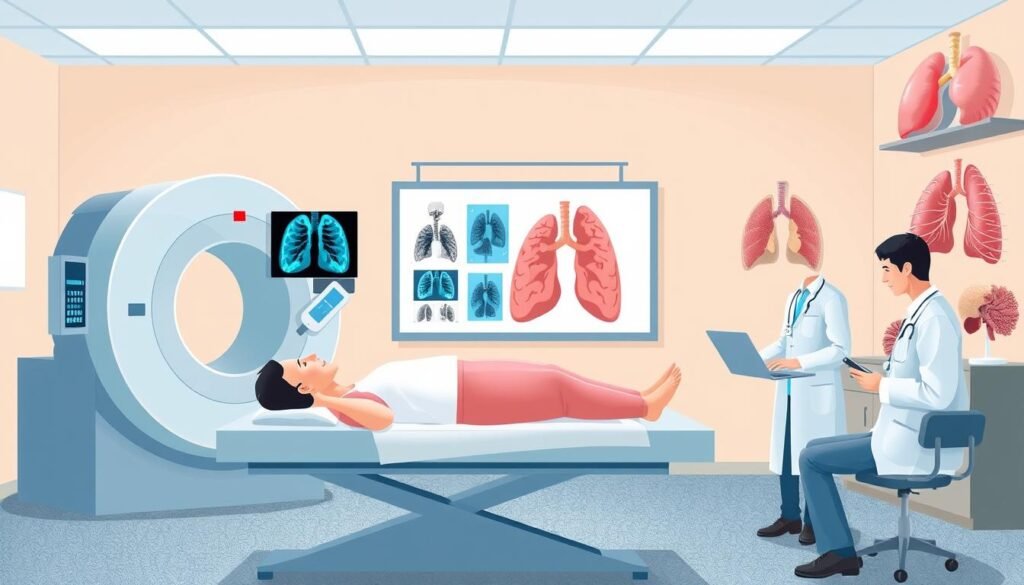About 3,000 cases of mesothelioma are diagnosed yearly in the US. In contrast, more than 235,000 cases of lung cancer are identified each year. This significant difference underlines that mesothelioma and lung cancer are not the same, despite both being related to asbestos exposure. Mesothelioma affects the lining around the lungs, while lung cancer is found within the lung tissue.
Knowing the differences between mesothelioma and lung cancer is crucial. Symptoms, diagnosis, prognosis, and treatment vary greatly between them. This article explores the contrasts between mesothelioma and lung cancer, giving essential insights for those facing these diseases.
Key Takeaways
- Mesothelioma is primarily linked to asbestos exposure, while lung cancer has multiple risk factors including smoking.
- Symptoms of both cancers can overlap, necessitating thorough diagnostic testing for accurate diagnosis.
- Mesothelioma typically has a poorer prognosis than lung cancer, with different treatment options and survival rates.
- Misdiagnosis is common due to similar symptoms, making it important to seek multiple opinions.
- Understanding the differences in how these cancers develop and spread can inform treatment decisions and care strategies.
What is Mesothelioma?
Mesothelioma is a rare, aggressive cancer mainly caused by asbestos exposure. It affects the mesothelium, a cell layer covering our organs. Knowing the mesothelioma types, causes, and symptoms is key to identifying it early.
Definition and Types
Mesothelioma mainly occurs in the pleura, or lung lining. It’s mostly pleural mesothelioma, but there are other kinds as well:
- Pleural Mesothelioma: This type impacts the lung lining and makes up about 75% of cases.
- Peritoneal Mesothelioma: Found in the abdominal lining, it represents a smaller number of cases.
- Pericardial Mesothelioma: A very rare kind affecting the heart’s lining.
Causes and Risk Factors
Asbestos exposure is the main cause of mesothelioma. Important risk factors include:
- Working in jobs where asbestos is present, like construction or shipbuilding.
- Secondhand exposure can occur when workers bring asbestos fibers home on their clothes.
- Having a family history of mesothelioma can also raise someone’s risk.
Symptoms of Mesothelioma
Spotting mesothelioma symptoms early can help improve survival chances. Some common symptoms are:
- Chest pain
- A cough that won’t go away
- Feeling short of breath
- Losing weight without trying
These symptoms might look like other conditions, so diagnosis is hard. Every year, doctors find 2,000 to 3,000 new cases in the U.S.
What is Lung Cancer?
Lung cancer is when cancer cells form in the lungs, affecting many people yearly. In 2022, the American Cancer Society estimates that over 230,000 people in the U.S. will be diagnosed. There are two main types: non-small cell lung cancer (NSCLC) and small cell lung cancer (SCLC). Knowing these lung cancer types is key for proper treatment.
Definition and Types
Non-small cell lung cancer is the more common type, making up about 85% of cases. It includes adenocarcinoma and squamous cell carcinoma. Small cell lung cancer, though rarer, grows quickly and is mostly caused by smoking. Each type needs different treatments, depending on how they grow.
Causes and Risk Factors
Smoking is a major cause of lung cancer, raising the risk a lot. Other risks include asbestos exposure, radon gas, and environmental pollutants. Being exposed to asbestos, especially for smokers, greatly increases lung cancer risk. Lung cancer from asbestos exposure usually takes 10 to 20 years to show up.
Symptoms of Lung Cancer
Spotting symptoms early is crucial. Common signs include a lingering cough, chest pain, and trouble breathing. There’s also coughing up blood. These symptoms are similar to other lung issues, so careful checks are important. For more on lung cancer and its connection to mesothelioma, click this link.
Mesothelioma vs Lung Cancer: Key Differences
It is key to know how mesothelioma and lung cancer differ for proper diagnosis and treatment. The main differences are where the tumors form and how they grow. These cancers also vary in their ability to spread.
Tumor Location and Development
Mesothelioma starts in the pleura, the lining around the lungs and chest. Lung cancer begins inside the lung tissue. These tumor locations lead to different signs and courses of the disease. Only about 3,000 people are diagnosed with mesothelioma each year in the U.S. In contrast, lung cancer affects over 230,000 people annually.
Growth Patterns
The tumor growth patterns also differ greatly. Mesothelioma forms as small nodules that may cover organs like a sheath. Meanwhile, lung cancer tumors are bigger and more defined. This affects not just how they are treated but also patient outlooks.
Spread and Metastasis
The way these tumors spread is another key difference between mesothelioma and lung cancer. Mesothelioma spreads slower and often stays in one spot longer. Lung cancer can quickly move to other organs, which makes treatment harder. Catching lung cancer early can lead to better outcomes. Click here for info on early lung cancer symptoms.
Causes of Mesothelioma and Lung Cancer
Many factors lead to mesothelioma and lung cancer. Both environmental and lifestyle factors play a role. It’s important to know these causes for prevention.
Asbestos Exposure
Asbestos is the main cause of mesothelioma. Around 80% of mesothelioma patients were exposed to asbestos. This risky material was used in many industries.
Construction workers, electricians, and firefighters have a high risk. Symptoms might not show up for 20 to 60 years after exposure.
Smoking and Environmental Factors
Smoking is the top cause of lung cancer but also affects mesothelioma risk for those exposed to asbestos. 80% of lung cancer deaths are due to smoking.
Radon exposure and air pollution are also to blame. Lung cancer’s latency period ranges from 10 to 30 years. Genes may also play a part.
Latency Periods for Both Cancers
Mesothelioma and lung cancer take different times to show symptoms. Mesothelioma can take 20 to 60 years. That’s why regular check-ups are essential for those exposed to asbestos.
Lung cancer’s latency periods range from 10 to 30 years. Smokers see their risk go up a lot. Here’s a look at how long these cancers take to develop:
| Cancer Type | Latency Period (Years) | Primary Causes |
|---|---|---|
| Mesothelioma | 20 – 60 | Asbestos Exposure, Erionite |
| Lung Cancer | 10 – 30 | Smoking, Radon, Air Pollution |
Common Symptoms of Mesothelioma and Lung Cancer
Both mesothelioma and lung cancer have symptoms that overlap, making early diagnosis tricky. People might face coughing, chest pain, fatigue, and losing weight without trying. These shared symptoms can make it hard to tell which condition a patient has. Knowing the differences between the two is key for the right treatment.
Shared Symptoms
Several symptoms show up in both mesothelioma and lung cancer. It’s important for doctors to recognize them. Common shared symptoms are:
- Coughing
- Chest pain
- Fatigue
- Unexplained weight loss
Differentiating Symptoms
Mesothelioma and lung cancer share many symptoms, but some are unique. Pleural effusion, or fluid buildup, often points to mesothelioma. On the other hand, lung cancer might cause continuous breathing problems or hemoptysis, which means coughing up blood. Spotting these unique signs helps in identifying the right condition for further tests.
Doing thorough medical exams and looking at patient histories is crucial. This way, doctors can diagnose correctly and plan the best treatment.
Diagnosis of Mesothelioma and Lung Cancer
Getting the right diagnosis is key in treating mesothelioma and lung cancer. Doctors start with imaging tests like X-rays and CT scans. These tests show if there’s anything unusual in the lungs or chest. After that, they confirm the disease by taking tissue samples.
Diagnostic Procedures
A few steps are common in diagnosing both types of cancer:
- X-rays: These are used first to spot any odd masses or changes in the lungs.
- CT Scans: They offer detailed cross-sectional images of any abnormalities.
- MRIs: These are good for understanding how far the disease has spread and its impact on nearby tissues.
- Biopsy Methods: Techniques like bronchoscopy, needle aspiration, and thoracoscopic surgery help get tissue for testing.
Using these methods, doctors can tell lung cancer from mesothelioma. This is vital for the right treatment. For more on these diagnostic methods, check this link.
Importance of Biopsy
A biopsy is crucial in the diagnostic process. It involves looking at tissues directly to confirm if a tumor is cancerous. The cell structure seen in biopsies helps tell mesothelioma from lung cancer. Being precise in diagnosing mesothelioma leads to better treatment plans. This improves patient survival rates. Likewise, accurate lung cancer diagnosis helps choose the best treatment.

Treatment Options for Mesothelioma
Finding the right treatment can greatly affect a patient’s life quality with mesothelioma. Different treatment options are considered based on the patient’s needs. These include the stage of the cancer, where the tumor is, and the patient’s health.
Standard Treatments
Standard mesothelioma treatments combine surgery, chemotherapy, and radiation. These aim to control the disease and ease symptoms. Surgery might involve removing parts of the lining around the lungs. However, not all patients can undergo surgery due to tumor locations. Chemotherapy often uses drugs like pemetrexed and cisplatin to shrink tumors or manage symptoms.
Palliative Care
Palliative care is crucial for advanced mesothelioma patients. It focuses on symptom management and improving life quality. Radiation therapy, for instance, helps reduce pain. The aim is to offer support, ensuring patients’ comfort even when treatments can’t cure them anymore. A team approach helps provide full support for the patient’s well-being.
Treatment Options for Lung Cancer
Lung cancer therapy varies, depending on the cancer’s type and stage. Treatments range from standard to emerging ones. They aim to fight the disease and better patient survival.
Standard Treatments
Standard lung cancer treatments include:
- Surgery: For tumors found in one area, surgery like lobectomy or pneumonectomy removes parts of the lung.
- Chemotherapy: Used in later stages, chemotherapy kills cancer cells and shrinks tumors with strong drugs.
- Radiation Therapy: This method uses high-energy beams to destroy cancer cells. It’s often used with other treatments.
- Targeted Therapies: These treatments attack specific parts of cancer cells for more tailored treatment.
Emerging Therapies
New treatments for lung cancer are being found through research. These include:
- Immunotherapy: This boosts the immune system to fight cancer, showing promise for different lung cancer types.
- Gene Therapy: By targeting cancer’s genetic mutations, gene therapy seeks to improve treatment results.
- Personalized Medicine: This customizes treatment based on a patient’s genes, aiming for better outcomes.
Clinical trials are key in developing new therapies for lung cancer. They offer patients access to cutting-edge treatments, possibly improving survival and life quality.

Mesothelioma vs Lung Cancer Prognosis
The outlook for mesothelioma and lung cancer is quite different. This affects how patients might fare. Mesothelioma patients usually live around 18 months after treatment. Lung cancer patients, however, often have a life expectancy of about a year.
Key factors like how early the cancer is found play a big part. So does how healthy the patient is overall and how well the treatment works. These elements are crucial for both diseases.
Finding the disease early and starting treatment right away helps a lot. Mesothelioma and lung cancer both need strong treatment plans. A study with 285 samples found big differences in their DNA patterns. This shows why accurate tests are so important.
More people, especially African Americans, are getting lung cancer. Knowing these differences helps doctors make better plans for each patient. As research gets better, focusing on improving the outlook for both diseases is key.
| Cancer Type | Typical Life Expectancy | Factors Influencing Prognosis |
|---|---|---|
| Mesothelioma | ~18 months | Stage at diagnosis, treatment efficacy, patient health |
| Lung Cancer | ~1 year | Stage at diagnosis, demographics, smoking exposure |
Survival Rates: Mesothelioma vs Lung Cancer
Survival rates between mesothelioma and lung cancer differ greatly. Mesothelioma patients typically live for 18 months after diagnosis. Only 12% survive for five years with pleural mesothelioma. Comparatively, almost 42% of lung cancer patients make it past one year.
Lung cancer has a brighter five-year outlook. When it comes to pleural mesothelioma, the outlook isn’t as good. Yet, peritoneal mesothelioma has a five-year survival rate of 65%, which is quite high.
Many factors affect these survival rates. Gender plays a role, as women with mesothelioma often live longer than men. Patients younger than 50 have a survival rate of about 75.2% for a year, while older patients’ rate drops to 49.6%. The type of treatment, stage of disease, and general health also matter.

Lung cancer shows better long-term survival thanks to treatment advances and early diagnosis. These numbers show the value of quick medical response and expert care for improving cancer outcomes.
Access to Specialists and Care for Both Cancers
Having the right specialists is key for those battling mesothelioma and lung cancer. Every year, more than 200,000 Americans are diagnosed with lung cancer. But mesothelioma is less common. This makes finding the right care even more crucial.
Those with mesothelioma often have to visit specialized centers. There, experts who know this cancer’s unique aspects can offer better care. They can help manage symptoms more effectively. Working with lung cancer experts, they provide a well-rounded treatment plan. This helps patients deal with their disease better.
About 16% of lung cancer patients live for five years after their diagnosis. It’s important for them to find doctors who understand their specific needs. Different people may face unique challenges in getting the care they need.
It’s essential to have a network of specialists for support during treatment. Below, see a table that shows what care is needed for both types of cancer:
| Aspect | Mesothelioma Care | Lung Cancer Care |
|---|---|---|
| Incidence Rate | Rare | High (over 200,000 annually) |
| Specialty Centers | Travel required to specialized clinics | More widespread access to specialists |
| Survival Rate | Varies by stage; generally lower | Approximately 16% over 5 years |
| Importance of Access | Critical for effective management | Essential for personalized treatment |
Conclusion
Understanding mesothelioma vs lung cancer means knowing their main differences. This includes their causes, symptoms, and how they are treated. Mesothelioma is mostly caused by asbestos. It has a risk of 0.02% per 1000 fibers per gram of lung tissue. Lung cancer, on the other hand, is often due to smoking and the environment.
It’s important to know these differences. This knowledge helps patients and families get the right care and fast diagnosis. Mesothelioma cases are increasing worldwide. However, lung cancer is still a top cause of cancer deaths. Catching the disease early greatly improves the chances of successful treatment.
Knowing all about mesothelioma and lung cancer helps patients manage their health better. It also helps doctors create more effective treatment plans. With ongoing research, being informed can lead to better health results. It can also improve life quality for those impacted by these diseases.